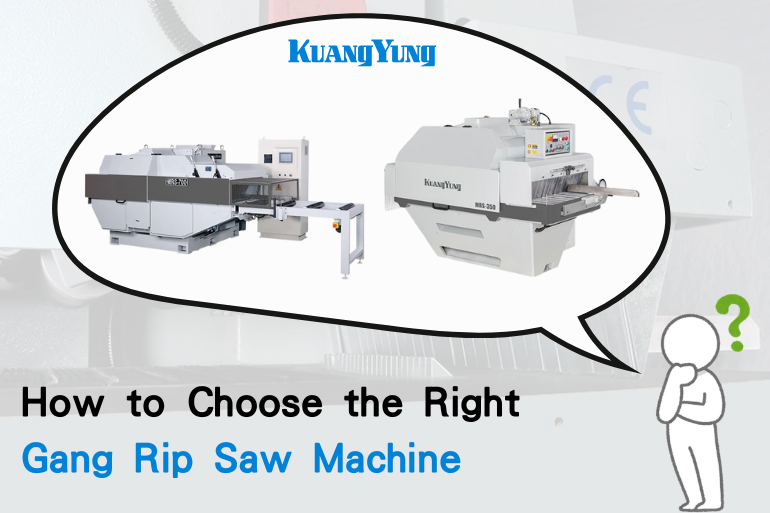How to Choose the Right Gang Rip Saw Machine for High-Volume Wood Cutting

FAQ 1: Why Do You Need a Fixed Multi Rip Saw?
When traditional single rip saw machines cannot meet large-scale processing demands,a multi rip saw becomes the best choice for high-capacity factories. With one feed,multiple cuts can be completed, improving efficiency and reducing labor costsespecially suitable for producing standardized products such as packaging materials,pallets, and building materials.
FAQ 2: What Is A Fixed Multi Rip Saw And What Types Does Kuang Yung Offer?
- Single Arbor Multi Rip Saw: Processes materials up to 155mm thick, suitable for large-volume, consistent specifications.
- Up&Low Dual Arbor Multi Rip Saw: Double rows of saw blades, suitable for heavy cutting of timber between 100-300mm.
- High-End Widen Multi Rip Saw: Can be used for direct panel joining after cutting, designed for ultra-wide processing such as MDF and plywood.
Whether the multi rip saw uses a single arbor or upper and lower arbors, it can complete multiple longitudinal cuts in one pass. With caterpillar feed design, the structure is compact, with high stability and precision.
FAQ 3: What Key Specifications Should You Check When Choosing A Fixed Multi Rip Saw?
- Quantity and specification of finished products, and matched motor power.
- Maximum cutting thickness required and blade specification selection.
- Optional designs for thin or short materials, or for direct panel joining after cutting.
- Feeding method (caterpillar feed / roller feed / belt feed).
- Safety and maintenance features (guards, anti-kickback system, lubrication system).
- Whether it needs to be equipped with an automatic infeed/outfeed system to save labor and reduce workforce requirements.
Selection should be based on raw material characteristics, product dimensions, production volume requirements, and automation needs.
FAQ 4: What Multi Rip Saws Does Kuang Yung Offer?
- MRS-12/300: Specially designed MRS-12/300 models are suitable for processing core board, finger joint wood, and furniture material preparation. MRS-12 is ideal for cutting short and thin materials under 85mm thickness; MRS-300 is suitable for general multi rip cutting up to 110mm thickness.
- MRS-350 / MRS-155 / MRS-175: Designed for heavy cutting needs, MRS-155 and MRS-175 handle material up to 155mm and 175mm thickness respectively. These models are built for powerful heavy-duty cutting, with maximum horsepower reaching 125HP.
- MRS-700 / MRS-730: Upper and lower arbor multi rip saws for secondary processing after log cutting, also suitable for mass processing of packaging materials, pallets, and wooden building materials.With ultra-thick processing capability and dual-motor power, MRS-700 cuts up to 220mm thick, th and MRS-730 up to 300mm, replacing band saw processing. Output is 2-3 times that of MRS155/MRS-175, and over 5 times that of a band saw.
- MRS-340 / MRS-450 / MRS-610: These are high-end, extra-wide processing models. With precision caterpillar feed and pneumatic pressing systems, finished cuts can be jointed directly, suitable for processing wide decorative materials such as particleboard and plywood.
FAQ 5: What Are The Pros And Cons Of Caterpillar Feed, Roller Feed, And Belt Feed?
| Feeding Method | Advantages | Disadvantages |
|---|---|---|
| Caterpillar Feed | Straight and consistent thickness in both vertical and horizontal planes. Kuang Yung high-end multi rip saws can cut directly for panel joining. | Higher cost, requires precise assembly quality. caterpillar and track are consumables. Wear of caterpillar and track upper arbor design may cause wood rebound. |
| Roller Feed | Lower cost. If arbor is positioned below, wood is less likely to rebound. | Cannot cut thicker wood; more prone to have banana-shaped deformation. Construction under the main arbor may cause jamming and sparks, leading to fire risk. |
| Belt Feed | Also low cost, can process wider wood. | Belt is more prone to damage and cannot process thicker wood. |
- Higher Cost: Caterpillar plates and tracks are precision machined to ensure straight cutting, even for thick panel joining. Particularly effective for long materials, making the high cost necessary.
- Caterpillar Track as Consumable: Use proper lubricants and regular maintenance; Kuang Yung uses Meehanite cast iron, and caterpillar plates/tracks are heat-treated and precision machined for 1.5x longer life than competitors.
- Wood Rebound Issue: All Kuang Yung multi rip saws are equipped with triple anti-kickback devices, designed to CE safety standards and TÜV CE certified for operator safety.
FAQ 6: Why Does A Caterpillar Feed Multi Rip Saw Sometimes Cut Crooked?
- Drying Process Issues: Uneven drying or moisture distribution can cause fiber stress imbalance, leading to stress release during cutting and resulting in crooked cuts.
- Wood Growth Conditions: Factors such as sunlight exposure, climate, and growth environment can cause inconsistent fiber alignment within the wood, affecting processing results.
FAQ 7: What Is The Main Difference Between Fixed And Movable Multi Rip Saws?
- Fixed Multi Rip Saw: Suitable when raw material widths are consistent; finished products are usually narrower. Commonly used for softwoods such as pine.
- Movable Multi Rip Saw: Suitable when raw material widths vary; finished products are usually wider.Commonly used for hardwoods such as oak, beech, or for first-stage log board preparation in sawmills.
Application Tip: If material sizes are consistent, fixed saws are more economical; if material sizes vary greatly, movable saws improve efficiency and product quality.
Want to know which fixed multi rip saw is best for your production line? Contact the Kuang Yung team for technical consultation and configuration advice.